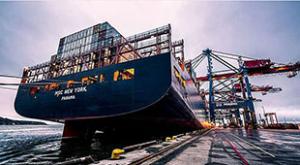All Features

Kari Miller
Quality management is essential to the growth and performance of any organization. It’s a valuable resource in the effort to ensure that products and services satisfy the highest quality requirements and deliver positive customer results.
Pharmaceutical manufacturers must ensure that the…

Kevin Ketels
The conditions that led to a shortage of baby formula were set in motion long before the February 2022 closure of the Similac factory tipped the U.S. into a crisis.
Retailers nationwide reported supplies of baby formula were out of stock at a rate of 43 percent during the week ended May 8, 2022,…

Albert Rees, Joe Vernon
The pandemic had many consequences for manufacturing companies, the most prevalent being supply chain disruption. In light of these disruptions, it is paramount that organizations establish robust and reliable operations to ensure productivity targets are met—especially as consumer demands continue…

NIST
A vulnerable spot in global commerce is the supply chain: It enables technology developers and vendors to create and deliver innovative products but can leave businesses, their finished wares, and ultimately their consumers open to cyberattacks. A new update to the National Institute of Standards…

Brandon Cornuke
Manufacturers work hard to minimize disruptions to their operations and invest significant resources to minimize production risk. They also are under constant pressure to find new ways to deliver more value to their customers. Sustainable business growth is critical to delivering this value. Many…

Rick Gould
As the world enters the third year of the Covid-19 pandemic, the climate crisis remains the biggest long-term threat facing humanity, according to the Global Risks Report 2022. Extreme weather due to climate change is seen as the second most serious short-term risk, with biodiversity loss coming in…

Eric Pauley
Organizations’ failure to properly manage the servers they lease from cloud service providers can allow attackers to receive private data, as research my colleagues and I conducted has shown.
Cloud computing allows businesses to lease servers the same way they lease office space. It’s easier for…

Jonathan Gilpin
Regardless of how much we, as a society, are able to implement and use technologies in business, global supply chains will always be dependent on the ways in which people interact with one another.
Even local supply chains can be problematic, but it’s predominantly global ones that can pose…

Marc Lepere
As the war in Ukraine rages, finance professionals on Wall Street and in Europe recently attracted outrage by suggesting that investing in arms manufacturers should be treated as ethical investing. In the fight against tyranny, they argued that such an investment “preserves peace and global…

William A. Levinson
Ryan Day1 describes how the rise of independent auto dealers is a “gray swan” event for the automobile industry. This was not only bound to happen, as observed by the author, but also long overdue. The article states, “...current state laws prohibit OEMs from selling new vehicles directly to…

Anthony Tarantino
In 2007, Nassim Taleb described black swans as highly improbable events that had dramatic or even catastrophic effects on markets and economies. Until recently, it seemed that such events were indeed rare.1 There’s now a major rethinking with the world entering the third year of the Covid-19…

Jonathan Gilpin
The world of procurement is often tricky. It involves choosing one appropriate candidate, ultimately benefiting them while rejecting and disadvantaging others.
That said, it isn’t just the businesses picked that will profit from winning the contracts; it’s also their supply chain, their local…

Tinglong Dai
Francis Fukuyama, the U.S. political scientist who once described the collapse of the Soviet Union as the “end of history,” suggested that Russia’s invasion of Ukraine might be called “the end of the end of history.” He meant that Vladimir Putin’s aggression signals a rollback of the ideals of a…

Georgia Tech News Center
With the United States’ semiconductor chip shortage likely to continue well into 2022, a Georgia Tech expert predicts that the U.S. will need to make major changes to the manufacturing and supply chain of these all-important chips to stave off further effects, including making more of them here at…

Jonathan Gilpin
The sheer scope of public-sector organizations’ requirements means many rely on the global supply chain. This involves buyers across the world procuring both goods and services from suppliers in destinations throughout the world. A global supply chain has benefits, many associated with price, but…

Kenny Tsang
The e-commerce industry is forecast to see substantial growth in 2022. Retail e-commerce sales in 2021 totaled $4.9 trillion, and may reach $5.42 trillion this year. Exponential growth in the sector has given rise to an ecosystem of millions of third-party sellers on sites such as Amazon that make…

Gary Steinberg
Disruptions in the global supply chain have led to a new dynamic for many small and medium-sized manufacturers (SMMs)—the need to be more strategic about “second sourcing” and reshoring. The biggest increase is in what’s referred to as second sourcing, which adds redundancies such as a second…

V R Vijay Anand
As the world moves toward a new, post-pandemic normal, industries must leverage digital transformation at an accelerated pace. This is already happening. According to IBM, 67 percent of manufacturers have accelerated digital projects since Covid-19.
Although improved operational efficiency is…

Sébastien Breteau
Although previous industrial revolutions were driven by steam machines and the dawn of electricity, the unfolding fourth industrial revolution is being powered by digital technologies, such as cloud computing, machine learning, and the internet of things. Accompanying the fourth industrial…

Jonathan Gilpin
The Chartered Institute of Procurement & Supply, a United Kingdom-based global professional body working for the purchasing and supply professions, suggests that every supply chain should enhance its diversity because this “can not only bring new ideas and solutions to an organization, but also…

Grant Ramaley
The IAF Medical Device Working Group has updated one of the most important documents that supports the medical device quality system ISO 13485. IAF MD9:2022—“Application of ISO/IEC 17021-1 in the field of medical device quality management systems (ISO 13485)” provides the mandatory requirements for…

Rodney Rohde
Medical laboratory professionals form the backbone of healthcare and the public health system. They conduct some 13 billion laboratory medicine tests annually in the United States. As of February 2022, these individuals had also performed more than 900 million Covid-19 tests and counting during the…

Ryan E. Day
ISO 9001:2015, Clause 6.1 introduces the term “actions to address risks and opportunities,” as a replacement for the standard’s previous term, “preventive actions.” The juxtaposition of “risks” and “opportunities” seems to imply a relational nature between the two concepts. But is it still…

Georgia Institute of Technology
This country’s semiconductor chip shortage is likely to continue well into 2022. Now, a Georgia Tech expert predicts that the United States will need to make major changes to the manufacturing and supply chain of these all-important chips to stave off further effects. That includes making more of…

Silke von Gemmingen
Lettuce is a valuable crop in Europe and the United States. But labor shortages make it difficult to harvest; finding sufficient seasonal labor to meet harvesting commitments is one of the sector’s biggest challenges. Moreover, with wages rising faster than producer prices, margins are tight.
In…